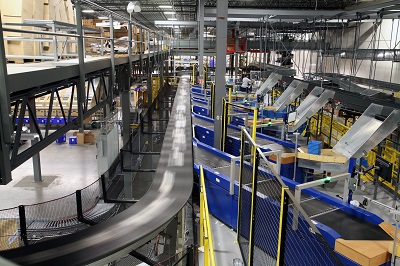Other Voices: Automation is a solution in today’s tight labor market
How automation like goods-to-person solutions and loop sortation can keep pace with growth using current staffing levels.

Editor’s note: The following column by John Sarinick, chief sales officer, BEUMER Corporation, is part of Modern’s Other Voices column, a series featuring ideas, opinions and insights from end-users, analysts, systems integrators and OEMs. Click here to learn about submitting a column for consideration.
————-
“Amazon plans a new fulfillment center in Monroe that could create 1,000 jobs”
“Kohl’s ramps up e-commerce and hiring with new distribution center”
“Amazon to build a $250-million regional fulfillment center, bringing at least 1,500 full-time jobs, with the possibility of thousands more in seasonal positions”
These headlines from recent months barely scratch the surface of the tremendous growth taking place in the distribution, warehouse and logistics industry. With each announcement comes a prediction of 600, 900 or sometimes a thousand or more new jobs. While this is great news for local Chambers of Commerce and economic development officials, it is less welcome news to those already dealing with the lack of available labor.
It is rare these days when I hear a client say that they don’t have a labor shortage issue. More typical are companies with manual operations that are struggling to keep pace with rising volume requirements. And what once was a seasonal issue is becoming a year-round challenge as the national unemployment rate hovers around 4%.
Most everyone wants to locate in strategic areas of the country with access to a large transportation network, which means the demand for labor is high while the supply is diminishing. And new competitors paying a slightly higher wage can disrupt an otherwise stable workforce.
Combatting the lack of available labor
So, what’s the answer for companies where increasing volumes and smaller orders are driving the need for additional labor and more handling capacity?
Automated sortation systems are an ideal consideration to accommodate increasing volumes. Technology from goods-to-person to high-speed sortation are flexible tools for addressing labor challenges and increasing accuracy and efficiency in order fulfillment. Loop sortation, for example, can alleviate complicated handling processes by accommodating a mix of products such as bags and cartons on a single system.
Continuing advancements in robotics also are making automated systems more attractive as robotic technology progresses to more closely simulate what humans can achieve. We’ve seen this in the pharmaceutical industry for quite some time as robotic arms grasp bottles that are all the same size.
Extending ROIs
Automated systems now under consideration by e-commerce, parcel and distribution centers could not be justified even five years ago. But labor shortages have spurred many companies to look more long-term and to extend ROIs on automation to ensure that they can keep pace with growth without a lack of labor being a roadblock.
Simply stated, the normal ratios have changed. Today, companies need such a higher percentage of labor for day-to-day and peak operations that it has upended the normal equations. This is especially true for companies that must repeatedly hire and train large numbers of temporary staff en masse. Such conditions can affect order accuracy, especially during peak times.
Designing for Growth
Automated systems should not only be designed to improve immediate needs, but to achieve year-over-year growth to a multi-year peak. For example, an existing facility now handling 10,000 pieces per hour with 300 workers can achieve 20,000 pieces with the same 300 workers with an automated system that is also designed to handle 20% growth annually.
For new facilities, automated systems allow greater productivity with fewer labor requirements. With automation, a new distribution center may need to hire only 300 people rather than 500, and in a tight labor market, that can make a big difference.
And while some predict that automation and cutting-edge technology will be destructive to the labor market long-term, new jobs will continue to be created with workers having the opportunity to learn new skills as existing roles are redefined.
About the Author
John Sarinick joined BEUMER Corporation in 2004 and now serves as chief sales officer responsible for sales, application engineering and marketing. His previous responsibilities also included engineering, project management and customer support. Sarinick contributes his experience in applying sortation solutions to many Fortune 500 BEUMER Group clients. Prior to joining BEUMER, he worked for IKA-Works, a leading provider of processing equipment systems. He has a BS in mechanical engineering and a minor in mathematics from the University of Buffalo.

Article Topics
Blogs News & Resources
Two voices of reason on pallet materials 60 Seconds with Bob Trebilcock, outgoing executive editor, Modern Materials Handling Learn from lift truck service history The reBound Podcast: How Pitney-Bowes is innovating with autonomous vehicles. Packaging Corner: Be open to change 60 Seconds with Robert Martichenko of American Logistics Aid Network The reBound Podcast: Looking for talent in all the right places: How Essendant is revolutionizing recruitment More BlogsLatest in Materials Handling
Beckhoff USA opens new office in Austin, Texas Manhattan Associates selects TeamViewer as partner for warehouse vision picking ASME Foundation wins grant for technical workforce development The (Not So) Secret Weapons: How Key Cabinets and Asset Management Lockers Are Changing Supply Chain Operations MODEX C-Suite Interview with Harold Vanasse: The perfect blend of automation and sustainability Consultant and industry leader John M. Hill passes on at age 86 Registration open for Pack Expo International 2024 More Materials HandlingSubscribe to Materials Handling Magazine

Find out what the world's most innovative companies are doing to improve productivity in their plants and distribution centers.
Start your FREE subscription today.
April 2024 Modern Materials Handling

Latest Resources










